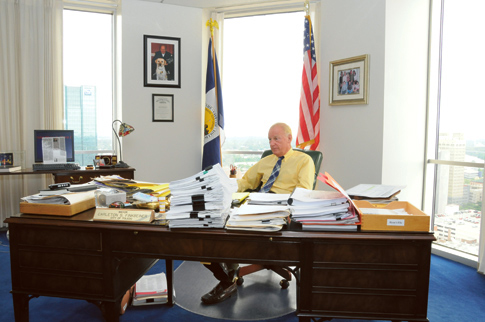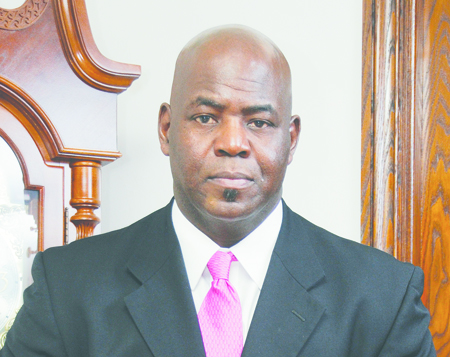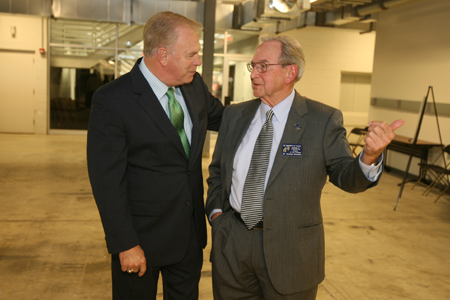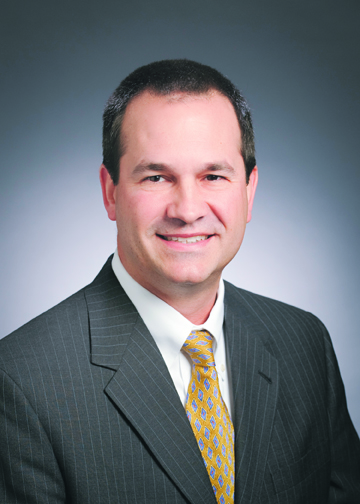Between 2005, when it began publishing, and June 30, 2012, Toledo Free Press, a weekly newspaper, published 97 articles with the keywords “solar industry.” Between Jan. 1, 1997, and June 30, 2012, The Blade, a daily newspaper, published 388 articles with those same keywords.
In the beginning, the two publications were almost of a singular voice on the topic.
In those 485 newspaper stories, the print media regularly turned to national, state, county and City of Toledo politicians and candidates — including Toledo’s mayor, an Ohio senator and House of Representatives member, the University of Toledo president, a UT president emeritus, a local broadcast TV news co-anchor, community leaders from the Regional Growth Partnership and the Toledo-Lucas County Port Authority, and local business men and women — for their perspective on Northwest Ohio’s solar industry.
Starting in 1997 and peaking in 2007, nearly everyone interviewed and everyone who submitted a guest column voiced support for the solar industry and the hope that it would become the salvation of the economic woes the area faced.
Some guest columnists proposed strategies they believed would ensure success. Others prodded Toledoans to develop attitudes that promoted the city and focused on its strengths. Many suggested that Toledo could become the solar hub, at that time referred to as “the next Silicon Valley” of the United States.
The solar industry enjoyed the unbridled support of almost everyone in Northwest Ohio.
Who were those people?
What did they have to say?
And, enjoying the 20/20 vision that comes with hindsight, what do some of those people have to say now?
Mayoral approval
Focused on building Toledo’s industrial base as well as promoting the city as one of America’s best, then-Mayor Carty Finkbeiner embraced the solar industry and all the potential it offered the city. If ever there was a political advocate for the solar industry, it was Finkbeiner.
In September 2007, Finkbeiner announced Toledo would work with the University of Toledo to develop the Ohio Center for Renewable Energy and Sustainable Development, a program the Lucas County Improvement Corporation predicted would pay huge dividends to Northwest Ohio’s economy.
Two months later, Finkbeiner wrote a column published in Toledo Free Press, declaring June 18, 2007, a symbolic day in Toledo’s history as wrecking balls knocked down the smokestacks at the Toledo Jeep Plant and Toledo began its transition from smokestacks and pollution to clean technology and alternative fuels. Finkbeiner said the solar industry, rooted in cleaning up and preserving the environment, would be Toledo’s economic future.
In April 2008, Finkbeiner touted Toledo’s foray into alternative energy, proclaiming that Toledo was “one of six solar energy capitals in the world,” projected to have 3 million jobs in the solar economy during the next 20 years.
Even as he faced the threat of a recall election in December 2008, Finkbeiner took the opportunity to plug the solar industry.
Refusing to let the recall petition effort demoralize him, Finkbeiner publicly suggested that Take Back Toledo, the group of opponents that organized the petition drive to unseat him during his 2006-09 term, should “also support us in working to bring alternative energy jobs and companies to Toledo.”
Recalling those days during a July 31 interview, Finkbeiner said, “Those Take Back Toledo people wanted change and people who are excited for change are very, very good for America. You need critics. If everybody agrees, you’re not getting the other opinion.
“I was challenging them. ‘Let’s use your energy and get behind the alternative energy thing. Put it into that, and we’ll move forward together.’
“I was just trying to challenge, as I always do,” Finkbeiner said. “That’s just my personality, to say, ‘OK. That’s your perspective. Why don’t we get behind the alternative energy thing and we’ll be working together on something. You put your energy, and I’ll put my energy, and two will be better than one. Let’s get at it.’ ”
A source of momentum Finkbeiner pointed to in December 2008 was Toledo’s growing reputation in the national media as a center of solar-energy innovation and manufacturing. Finkbeiner took tremendous pleasure in January 2009 when Foreign Direct Investment magazine named Toledo the “Most Business Friendly City in North America.” He said at the time that the national recognition must motivate the community to increase “support of growing advanced technology businesses by encouraging an entrepreneurial mindset and funding research that fuels growth.”
Bell at the helm
When Mike Bell moved into the mayor’s office Jan. 4, 2010, beating Democrat Keith Wilkowski by a margin of 2 percent of the popular vote, the local print media reported he would not follow Finkbeiner’s lead as a solar energy advocate.
In an interview July 25, Mayor Mike Bell said he did not choose to not make the solar industry a part of his agenda. When he took over in January 2010, the City of Toledo was $48 million dollars in debt. He felt it most important to find a way to get Toledo out of the red.
One avenue was to investigate the possibilities that Asian investors had an interest in Toledo.
Bell said that since the city faced a $48 million debt, he didn’t even think to consider Finkbeiner’s solar push. His focus was the $48 million debt, not the outgoing mayor’s agenda.
Bell said the solar industry was already established in Northwest Ohio, and he didn’t think focusing on it would bring the financial solution Toledo needed. In his judgment, pursuing Asian investor interest would pay quicker dividends.
“When you ask me about this two-and-a-half years later, I would point out the fact that we’re out of debt and actually have a surplus in the city budget,” Bell said. “I’d say that’s proof I made the right decision.”
Bell said he thinks the solar industry is, and will continue to be, an important part of Toledo. However, he says it has issues to solve, like making solar panels affordable for homeowners who want to install them in their homes. He feels confident the solar industry will continue to be a part of Toledo, and now that the city has a surplus in its budget, he may have the luxury to look at other things. Bell said he most needed to improve the city’s budget issues, and he’s pleased that he’s done that.
“I say, ‘Finkbeiner pooh-poohs that explanation. He didn’t have the deficit he claims to have had,’ ” Finkbeiner said July 31. “Let’s just be very blunt. First, there was no $48 million deficit. That was a Mike Bell, Steve Herwat (deputy mayor of operations) made-up figure. I can prove it. I’ve been to The Blade. They all didn’t want to get into it.
“His debt was exactly what my debt was the last year I was mayor (2009). The bottom fell out of the American economy and the Toledo economy. It was in October 2008, one month before the presidential election.
“The American automobile industry is very relevant. The American automobile industry was fleecing Toledo. We dropped $28 million in anticipated revenue from 2007 to the end of 2008. To be precise, when I began my last year as mayor in 2009, it was $27.7 million debt that I had to make up during the year 2009.
“I didn’t make it all up. I made all of it up but about $4.5 million. So that $27.7 million that I had as a deficit to make up in 2009 was also what Mr. Bell had, because the economy was just as flat in 2010. He had $27.7 million plus $4.5 million that I did not balance the budget with (for a total deficit of
$32.2 million, not $48 million).
“The automobile industry is what brought the present black-and-white situation back. That’s what did it. Period. End of discussion. There’s no question.
“And the casino. The Jeep plant and the casino both have put the coffers back in respectful [shape]. No budget cutting. No fewer and no more bodies working for the city.
“And, secondly, [making up the deficit is] no explanation to running off to China thrice.
“And at the moment, I don’t know of one single job that’s been created in Northwest Ohio as a result of all those trips to China. Not a single job,” FInkbeiner said. “If you find one and point it out, I’ll accept your correction.”
In Dec. 2011, however, Bell did publicly support a landfill reclamation project that had the potential to substantially boost Toledo’s credentials as a solar-energy hub.
OCI Solar Toledo City LLC, a partnership of two international energy companies, OCI Solar Power and CME Energy, invested an estimated $20 million into plans to install an 80-acre solar-energy field on top of capped landfills in North Toledo next to I-75, located close to Chrysler’s Toledo Assembly Complex.
The project, which was predicted to generate enough electricity to power as many as 7,000 homes upon completion in 2013, was to be the largest solar-energy installation in Toledo.
In late 2011, plans were for OCI Solar Toledo City to also lease landfills from the City of Toledo for about $20,000 a year. Reports suggested that Toledo Public Power might buy energy generated from these solar fields and resell it. The end-users of that power could be local businesses and residents.
Bell said the project was a common-sense use of land that otherwise would not be redeveloped.
“It’s land that we couldn’t do anything else with,” Bell said, “so it’s nice that we’ve found something positive to do on that piece of property that will help our community.”
Democrats in charge
Democrat Ted Strickland was governor of Ohio when the solar energy industry took off in 2007. Strickland relinquished the office in 2011 after Republican John Kasich defeated him in the Nov. 2, 2010, election, with 49.09 percent of the vote to Strickland’s 47.04 percent.
Under Strickland, the Toledo-area solar energy companies flourished. Strickland visited Toledo often in the late 2000s to take part in ceremonies, such as when more than 1,400 panels made in Perrysburg’s First Solar plant were installed on the Toledo Museum of Art’s rooftop. The panels were meant to help the museum generate enough power to handle one-fifth of its energy needs.
A portion of the installation project was funded by the state through an Ohio Department of Development grant. Strickland joined local political and business leaders the day of the installation ceremony, heaping praise on the project.
“This is but one example of what can be done to make our state more progressive [and] to make us less dependent on outside supplies for our energy needs,” Strickland said. “We will look back maybe 10, 20 years from now, and we will realize the significance of what’s happening with our economy today.”
While in office, Strickland supported an alternative energy agenda, specifically backing Ohio’s Senate Bill 221 which required 25 percent of all Ohio’s energy to be generated through alternative means by 2025. That bill became law in May 2009.
In a Toledo Free Press guest column, April 4, 2008, Karl Rundgren, then managing editor and co-anchor of FOX Toledo News, praised the national attention Toledo had received for its focus on green technology that same week when CNN ran a report that featured First Solar and Xunlight.
Rundgren foreshadowed the 2009 mayoral recall drive when he pointed out a warning in that same CNN report.
“These jobs are developing, but they’ll go to the place that is prepared for them,” Rundgren wrote. “Communities that delay and debate might find themselves doing without, watching as other cities become the capitals of alternative energy. While Toledo is doing well now, I worry that we could end up our own worst enemy. Our history of territorial griping, finger pointing and baseless threats could lead to a pathetic squabble that costs time and, ultimately, jobs.”
Republicans in charge
When Kasich took office, his Republican-led administration criticized Strickland and former Lt. Gov. Lee Fisher for how Ohio’s $8.2 billion in federal stimulus money from the President Barack Obama-supported American Recovery and Reinvestment Act of 2009 was dispersed. Although Kasich never publicly criticized Obama, members of his administration questioned Strickland’s relationship with executives at Toledo’s Willard & Kelsey Solar Group LLC, suggesting that the $23,400 worth of 2010 campaign contributions by four Willard & Kelsey executives were improper and indicated favoritism from Strickland.
On March 10, 2010, State Sen. Mark Wagoner joined fellow Republicans in criticizing Strickland. They called for the governor to be more open to “game-changing investments,” such as the rejected proposal offered by local solar company executive Norm Johnston, chairman of nonprofit group Ohio Advanced Energy, vice chairman of Germany’s Calyxo GmbH and chief executive of Calyxo’s North American subsidiary, to use state funding to cover 30 former industrial sites with solar panels.
Johnston had complained about the Strickland administration’s rejection of his $750 million proposal to build 30 solar fields on cleaned-up industrial sites throughout Ohio.
Johnston claimed Strickland was to blame for Ohioans not having thousands more jobs in solar industry in 2010.
Strickland countered, saying he put emphasis on solar and other renewable energies as two of the most exciting prospects for reversing what he said felt like a decade-long recession in Ohio. Strickland said his approach would have resulted in thousands of solar jobs for Ohioans. Then-gubernatorial candidate Kasich criticized Strickland over what Kasich said was the disappearance of some 300,000 jobs during Strickland’s administration.
Strickland asserted that his solar policy adjustments would have created more jobs sooner had Republicans not opposed legislation that would establish a market for solar products.
Republicans reacted angrily to the suggestion they opposed any job-creating legislation.
“We passed Senate Bill 221 … that moved advanced alternative energy further down the road in Ohio, and that was a very bipartisan effort to do so,” Rep. Randy Gardner said. “The strongest champion on SB 221, I think, was at the time [former Republican House leader] Jon Husted.”
One Republican’s strategy
The animosity between Ohio’s Democratic and Republican parties escalated in April when Jeff Jacobson, former Republican lawmaker and current secretary-treasurer of The Ohio Air Quality Development Authority (OAQDA), moved to turn over three Toledo-area solar companies to the attorney general’s collections department for failing to make scheduled payments on millions in low-interest state loans issued in 2010.
“I don’t know why companies would think it’s OK to take our money and not pay,” Jacobson told media April 15. “Us doing nothing is not a good reaction to something like that.”
Other OAQDA members did not support Jacobson’s motion. Jacobson acknowledged that he didn’t expect his motion to garner support, but said he made it to send a message from Kasich’s administration to Ohio companies that the OAQDA is keeping detailed records and expects to be paid back the money it loans.
Katie Sabatino, an Ohio Department of Development spokesperson, said such drastic measures may become common if businesses “don’t live up to the commitments they promised [because] we’re going to take appropriate action. We want to make sure we’re being business friendly in letting them repay their loans, but still being good stewards of taxpayer dollars.”
Willard & Kelsey Solar and Xunlight Corp. have made interest-only payments on Advanced Energy loans of $5.1 and $4 million, respectively. This despite the fact that their loan agreements required them to make principal payments. Willard & Kelsey’s $5.1 million loan and a separate $5 million loan from the Department of Development will come due Sept. 30.
On April 15, Mossie Murphy, Willard & Kelsey’s chief financial officer, insisted that the firm never misused state funds and always complied with state law. He said private funding, which had also been scrutinized in the local print media, is used at the discretion of Willard & Kelsey’s executives and not subject to public review.
“We view the state money as sacred, and the state loans we fully intend to pay,” Murphy told media.
The third firm, Buckeye Silicon of Toledo, has not made a $2,400-a-month interest payment on its $1.4 million loan in 2012, although the firm was supposed to begin paying $25,000 a month on principal starting May 2012.
Educational leadership
Toledoans appreciated the notoriety then-Gov. Strickland brought their city when he christened Northwest Ohio an official hub of solar energy research and innovation, on July 1, 2010. Many saw the ceremony as an economic-development coming-of-age party intended to boost investment and create local jobs in alternative energy.
Strickland’s ceremony confirmed something that Dan Johnson, then-provost and chief operating officer of Zayed University, Dubai, United Arab Emirates, and UT president emeritus, already knew. A year earlier, Johnson expressed that same pride and delight when he saw UT and Xunlight accept leadership roles in the international solar energy industry by representing Toledo at the World Future Energy Summit in Abu Dhabi, UAE.
Johnson encouraged more members of the Toledo business and educational communities to attend future summits.
In a Toledo Free Press guest column Feb. 13, 2009, Johnson wrote, “To compete, we must have a strategy that recognizes and takes into account what is happening globally as well as nationally and locally. Participating in the World Future Energy Summit was a good move and one that should be repeated every year.”
Frank Calzonetti, UT’s vice president of research and development, praised Johnson’s strategy, saying UT’s decision to attend the summit spoke volumes about Toledo’s commitment to the solar energy industry.
“Our presence at this meeting sends a message that we are a global player and gives us an opportunity to show leading companies, investors and government officials why Toledo is a good place for research collaboration, business location and investment in renewable energy,” Calzonetti said.
More than three years later, Johnson said he has been privileged to attend the past three World Future Energy Summit conventions and “see the global input into the development of solar energy. There are literally hundreds and hundreds of companies worldwide involved in solar energy research and development.” That exposure has convinced Johnson that “we must collaborate together.”
“What we’ve seen happen in Toledo [these past four years] in terms of response to specific solar industry companies is the result of a shift of policy decisions,” he said.
“The enthusiasm we saw here in the United States in 2008 produced a considerable investment and a large number of startups. As those start-ups developed and matured, the market and business cycles took over.
“Look at the auto industry as an example. Almost, if not all, the start-ups 75 years ago are gone now,” Johnson said. “The industry grew, and as technology developed the startups of the early 20th century gave way to other companies.
“The shake-up we see happening in the solar industry could have and should have been expected. It’s a natural process in the business cycle. If you look at it from a global perspective, it’s a pattern we see in all new industries.
“It’s also very important to recognize that demand for solar energy is affected by policy. We’ve been strong on the technical development side. We need to be as strong on policy issues.
“Also, although we have been strong on things like technological development, we have not been strong on marketing supply. Some companies and some countries have done it better than others. We have much to learn about how to market solar energy.”
Johnson insists “there is still a lot of potential for Toledo. However, we need to have strong leadership in this area. We need leadership. Where will it come from? That will be interesting to see.”
Finkbeiner said the leaders for economic development in this region are the University of Toledo and Bowling Green State University, the Regional Growth Partnership (RGP), the Port Authority and the mayor.
“The University of Toledo has been a tremendous leader because it has the wherewithal and the staff to assist with the research and development aspect of things as they did with Harold McMaster.”
In discussing Willard & Kelsey’s continuing research and development, including 3-by-6 and 4-by-8 solar panels and higher-than-industry-standard, energy-efficient solar windows, Michael Cicak praised UT’s researchers and their work with his firm.
“You can’t sell the University of Toledo short,” Cicak said July 19. “They have some damn good people who are working very, very diligently with us with some projects.”
Cicak, chairman and CEO of Willard & Kelsey, was an original partner with Harold McMaster in the pioneering developmental work UT did with GlassTech Solar in 1984 and Solar Cells, Inc. in 1990. Solar Cells eventually became First Solar after being bought by True North Partners, LLC in 1999 and renamed First Solar, Inc.
Community leadership
Finkbeiner said he is particularly disappointed in what he called a lack of leadership from the RGP and the Toledo-Lucas County Port Authority, organizations that he said played a major role in promoting the solar industry from 2006-09.
As an example, Finkbeiner pointed to Steven Weathers, then-president and CEO of the Regional Growth Partnership, who came out on June 8, 2007, in strong support of the University of Toledo’s Northwest Ohio Science and Technology Corridor as a way to diversify and stabilize the region’s economy.
“I see it as the branding of an area like Silicon Valley where we can bring together all the components of economic development within Northwest Ohio, becoming a center of innovative technology in addition to automotive manufacturing,” Weathers said.
The RGP is responsible for marketing and promoting Northwest Ohio. The Port Authority aims to generate transportation and economic development in the Toledo area. Finkbeiner said both have “dropped the ball.”
In RGP’s defense, its president and CEO, Dean Monske, said that through RGP’s editorial marketing program, “We continuously communicate with national and international media, promoting our regional strengths, assets and success stories.
“When we began pitching our regional solar story in 2007, we were fortunate to catch the media at a time when ‘green’ industry was the hot topic. What resulted were dozens of stories about this region in top-tier media outlets across the world. Today, we still pitch this story on a national level, but most media interest comes from industrial trade publications.
“Most growth in the local solar industry has taken place in the creation of new startup companies. The lead entity in working directly with technology startups is Rocket Ventures, LLC, a venture capital organization created as a joint venture in 2011 through the RGP and University of Toledo Innovation Enterprises,” Monske said.
Prior to the joint venture, Rocket Ventures operated directly under the RGP, where it worked with technology-based startups, including solar companies, Monske said.
“The recent merger presents a more sustainable and lower-cost platform to continue providing services to technology-based clients,” Monske said.
“Undoubtedly, the global economic downturn has hampered growth in solar,” Monske said. “However, with our core capacity in this industry, combined with our regional competitive assets spanning the traditional sectors such as workforce, geographic location, education, transportation and quality of life, Northwest Ohio can maintain and enhance its standing as a major player in the industry.”
The ultimate responsibility
Finkbeiner also pointed to the mayor, whom he said “remains the most important” leader in the region’s economic development.
“Those three organizations (UT, the RGP and the Port Authority), and that one individual, is where the responsibility lies. The glory goes to them if we gain and grow jobs, and the responsibility is on their shoulders if we don’t do that,” Finkbeiner said.
“I believe that one, if not the most important reason [for the decline of the solar industry in this area], is all of the attention, excitement, glory and journalism following the very early Mike Bell-tenure trip to China. It took us off the message. It took us off focus. We began to look at the relationships with China, not the rest of the world, as the single most important economic development initiative. And I haven’t heard hardly a word about alternative energy since that China topic was introduced.
“In this man’s opinion, the Chinese have not created hardly a job in the United States of America. They’re investors in real estate in this country. They aren’t manufacturers. They aren’t doing major technology investments. They’re basically real estate investors — a hotel in Downtown Toledo, the Marina District, and a docks property in East Toledo — but the jobs are not a part of their mission.
“Since we got so involved with that China thing, I haven’t heard, read hardly a word about alternative energy and its significance.
“Some region of the United States is going to be a major player in alternative energy programs, starting with research and development, the manufacture at a cost-efficient scale of alternative energy. The world is overheating. It’s becoming more and more known to even the doubting Thomases, and we can’t continue to be held hostage to dictators in other parts of the world who don’t really share our belief in democracy, in freedom, in respect for women.
“And so just to get their oil, we sell our principles and our very important constitutional guarantees of freedom and opportunity. We sell those out just to get oil and support dictators that are harsh, unfair to significant parts of the population.
“But we, within the confines of the continental United States, need to be that region that isn’t guided by gray skies, as you now know.”
Finkbeiner also discounted any argument that sunnier climates might steal Toledo’s solar energy potential.
“I didn’t know this until the last two or three or four years ago when I asked the question, ‘Are we going to be foreclosed upon to the Arizonas and the Californias because of their supposedly clear skies and sunshine?’
“The response that I got was, ‘No. It has nothing to do with that or First Solar wouldn’t have picked that site in Toledo to locate.’
“So I’d say the sun is still rising on alternative energy options,” he said.
“I hope that alternative energy advocates, including Northwest Ohioans like Marcy Kaptur, Bob Latta and Sherrod Brown, will continue … not just with whatever the popularity quote of the month is. We have got to be consistently keeping our eye on any development opportunities in the field of alternative energy that we might be able to welcome to Northwest Ohio, using the resources at UT.”
Sources:
Newspaper sources
1. Toledo Free Press, “Plan to transform regional economy”, Duane Ramsey, June 8, 2007.
2. Toledo Free Press, “Transforming Toledo”, Tom Pounds, June 8, 2007.
3. Toledo Blade, “Catching up on tech grants – Frozen out of funds early in program, area intensifies effort”, Jon Chavez, Sept. 23, 2007.
4. Toledo Free Press, “Advanced energy activity ‘encouraging’ ”, Brooke Brockschmidt, Matt Sattle and Shawn Ferguson, Sept. 28, 2007.
5. Toledo Free Press, “2007: A year of recognition and defined vision”, Carty Finkbeiner, Dec. 28, 2007.
6. Toledo Free Press, “Toledo 2020: Engaging future stakeholders”, Dan Johnson, Jan. 4, 2008.
7. Toledo Free Press, “RGP fosters technology”, Steve Weathers, Jan. 25, 2008.
8. Toledo Blade, “Middle East nation may invest here, mayor says – Economic team has 101 companies on list”, Ignazio Messina, April 2, 2008.
9. Toledo Free Press, “Alternative energy: Making lemonade from the lemons”, Dan Johnson, May 2, 2008.
10. Toledo Free Press, “Toledo company develops technology for cleaner biofuel”, Duane Ramsey, May 25, 2008.
11. Toledo Blade, “Analysts cool on First Solar – New competitors, high stock price spur ratings dip”, Gary T. Pakulski, June 8, 2008.
12. Toledo Free Press, “Toledo’s future in alternative energy”, Dan Johnson, Aug. 1, 2008.
13. Toledo Free Press, “Business-led effort aims to recall mayor, establish PAC”, Scott McKimmy, Dec. 4, 2008.
14. Toledo Free Press, “Toledo turns to solar to revive city”, Associated Press, Dec. 8, 2008.
15. Toledo Blade, “Finkbeiner bullish on city’s prospects for development – Mayor’s critics see lack of progress”, Tom Troy, Dec. 28, 2008.
16. Toledo Blade, “City making strides, mayor says – His annual talk cites alternative energy”, Ignazio Messina, Jan. 6, 2009.
17. Toledo Blade, “Solar field’s backers ask Toledo Council to invest”, Ignazio Messina, Jan. 15, 2009.
18. Toledo Free Press, “What 2009 offers”, Steve Weathers, Jan. 16, 2009.
19. Toledo Blade, “Council OKs $65,000 for solar project”, Ignazio Messina, Jan. 21, 2009.
20. Toledo Free Press, “Regional cooperation is bold step in right direction”, Carty Finkbeiner, Jan. 23, 2009.
21. Toledo Free Press, “Toledo at the World Future Energy Summit”, Dan Johnson, Feb. 13, 2009.
22. Toledo Free Press, “Local public, private sources file for stimulus money”, Duane Ramsey, March 6, 2009.
23. Toledo Blade, “Thin is key for First Solar – Cost-saving production is choice for it, Xunlight”, Gary T. Pakulski, May 31, 2009.
24. Toledo Free Press, “Can Toledo re-invent itself?”, Dan Johnson, June 9, 2009.
25. Toledo Free Press, “SSOE ranked among fastest-growing firms”, Duane Ramsey, Oct. 8, 2009.
26. Toledo Blade, “First Solar plant re-energized – Expansion reflects growth in demand across N. America”, Gary T. Pakulski, Nov. 22, 2009.
27. Toledo Blade, “Third Frontier: A good investment for NW Ohio”, Steve Weathers, Dec. 10, 2009.
28. Toledo Free Press, “UT honors efforts of Abu Dhabi energy company”, Kristen Criswell, July 29, 2010.
29. Toledo Free Press, “Expanding our economic horizon through alternative energy”, Dan Johnson, July 29, 2010.
30. Toledo Blade, “Obama’s rosy take on Toledo imprecise; Area’s clean-energy progress overstated”, Joe Vardon, Aug. 22, 2010.
Online sources
31. Ask.com, “Carlton S (Carty) Finkbeiner second term; 2006–2010”,
http://www.ask.com/wiki/List_of_mayors_of_Toledo,_Ohio
32. Ask.com, “Michael Bell (Mayor)”, http://www.ask.com/wiki/Michael_Bell_(mayor)
33. Ask.com, “Presidential Election 2008”, http://www.ask.com/wiki/United_States_presidential_election,_2008
34. CBS News, “Stimulus recipient under investigation for insider trading”, Laura Strickler, March 22, 2012, http://www.cbsnews.com/8301-31727_162-57402463-10391695/stimulus-recipient-under-investigation-for-insider-trading/
35. City of Toledo, “Mayor’s Office Staff”, http://www.ci.toledo.oh.us/MayorsOffice/MayoralStaff/tabid/267/Default.aspx
36. Nasdaq.com. “Interactive Stock Chart – First Solar, Inc.”, http://www.nasdaq.com/symbol/fslr/interactive-chart
37. Recovery.gov, “The Recovery Act”,
http://www.recovery.gov/About/Pages/The_Act.aspx
38. ToledoFreePress.com, “Sun Burn 1: Area courted solar energy with research”, July 19, 2012, https://toledofreepress.com/2012/07/19/sun-burn-1-area-courted-solar-energy-with-research/
39. ToledoFreePress.com, “Sun Burn 2: Global changes slow solar growth”, July 26, 2012, https://toledofreepress.com/2012/07/26/sun-burn-2-global-changes-slow-solar-growth/
40. Wikipedia.org, “Ohio Gubernatorial Election 2010”, http://en.wikipedia.org/wiki/Ohio_gubernatorial_election,_2010
41. Wikipedia.org, “SSOE”, http://en.wikipedia.org/wiki/SSOE



























